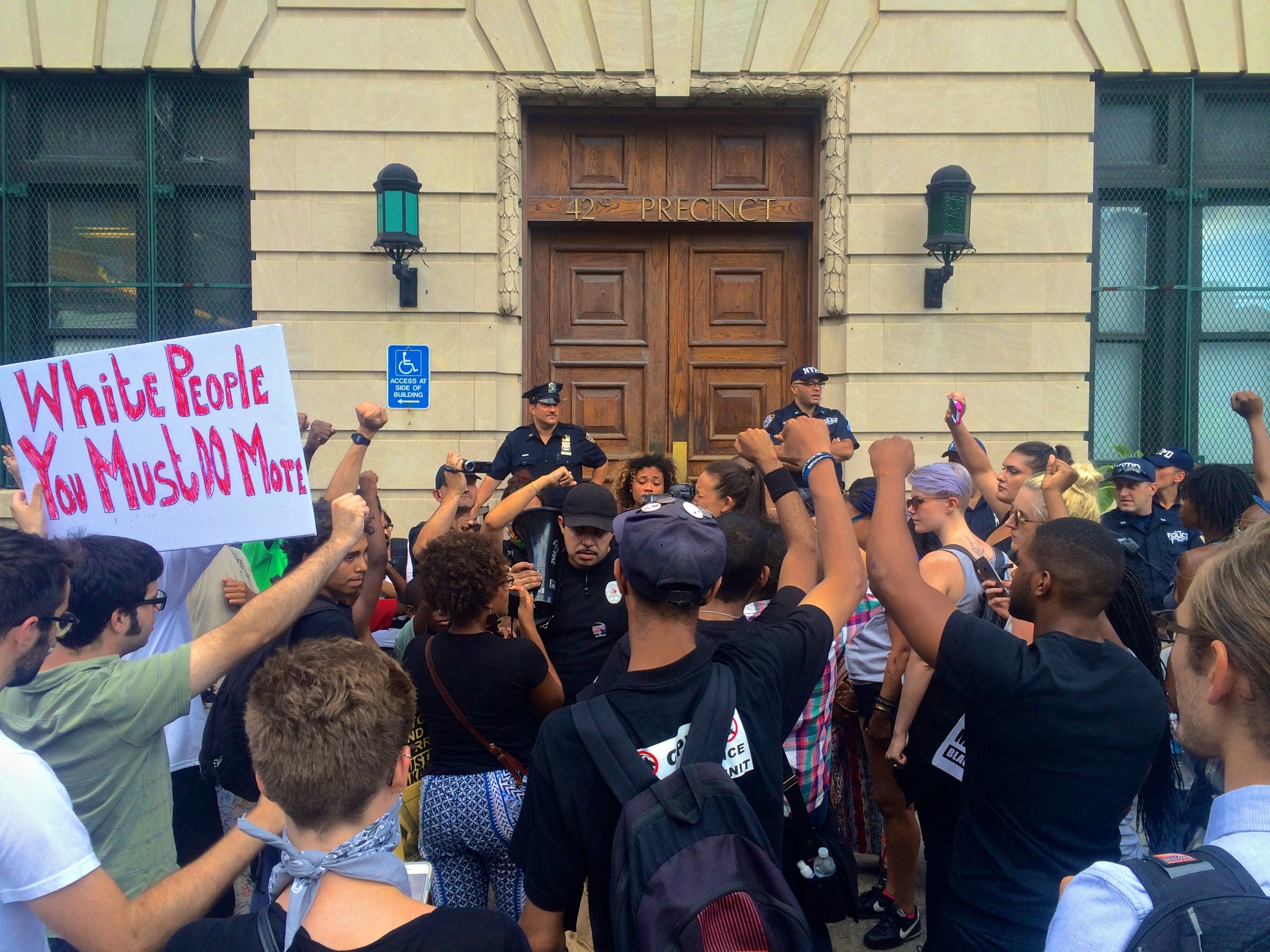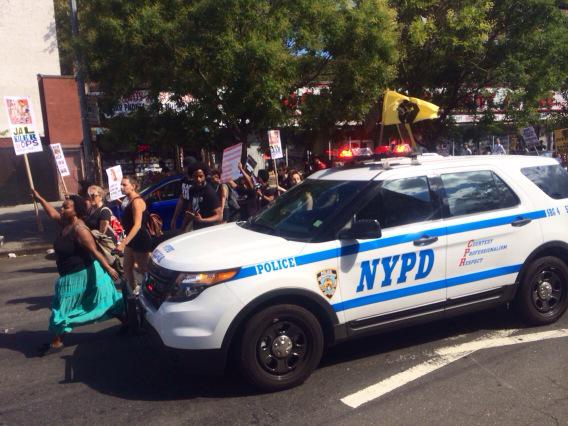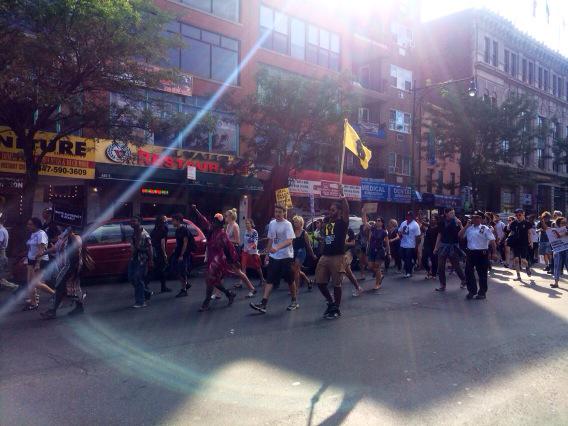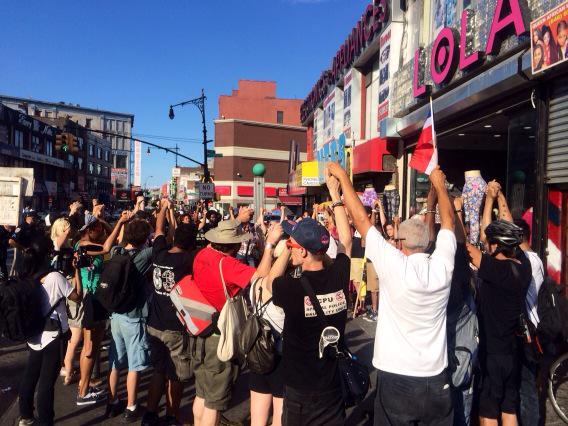Filed under: Action, Incarceration, Northeast, Police, Repression, White Supremacy

Originally posted to It’s Going Down
by Ash Jegroo
While Ferguson and other cities here in the US (and even in the UK) held rallies and marches to commemorate one year passing since the murder of Michael Brown by Officer Darren Wilson, New York City’s #BlackLivesMatter movement shut it down for Mike Brown on August 9 with three different actions in Manhattan and Brooklyn.
The first action started at 12pm in front of the Barclays Center in downtown Brooklyn and was organized by a coalition of various groups known as The Black Summer Coalition. This coalition includes Africans Helping Africans, FIST, Millions March, Peoples Power Assemblies, NYC Shut It Down, and Why Accountability. As people started to gather, speakers from the different groups addressed the crowd. Anita Neal, the mother of Kyam Livingston who died in a Brooklyn jail cell in 2013, carried a sign bearing Sandra Bland’s face and talked about people dying in police custody. Shannon Jones of Why Accountability gave an incredible speech calling out NYC’s liberal politicians, the mainstream media, and the nonprofit-industrial complex. Elsa Waithe of NYC Shut It Down broke down the facts on how often black people are killed by police and how often they are unarmed when they’re killed.

After the speakers were done, the protesters took over Brooklyn’s streets while the NYPD helplessly tried to get all the marchers onto the sidewalk. The marchers stomped down Fort Greene Place chanting Mike Brown’s name. When they reached Fulton Street, in a part of Fort Greene undergoing gentrification, one protester yelled to the onlookers: “We’re taking it back!”
The march continued down Fulton with two arrests being made (including yours truly) on the way to a nearby courthouse. Once the protesters got there, the organizers advised everyone to take the train to the next action in Harlem.
The march in Harlem, organized by Copwatch Patrol Unit’s Jose LaSalle, started on the corner of 125th street and Adam Clayton Powell Boulevard. LaSalle, along with other speakers, reminded the crowd of the power of filming the police and that videos of police brutality are one of the things that have helped raise public awareness of the cops’ brutality as well as unified and galvanized the movement. Jones, who also spoke at the Harlem march, warned that viral videos of NYPD officers doing trendy dances with kids meant nothing if the police were still criminalizing and brutalizing youth of color.

“Remember the NYPD is not a social justice group. They are not a social service provider. I don’t care how many times you see the NYPD doing the Nae-Nae with your children,” Jones said. “They will lock up your child. They will arrest your child. They will criminalize your child. They will disrespect you child and come out here and do the Nae-Nae on you.”
When the marchers finally took over Harlem’s streets, they started heading uptown. Protesters took over control of the streets for the most part with a few minor sidewalk interruptions. By the time the protest got to 135th and Madison to march into the Bronx, the NYPD got ahead of the marchers and blocked off the Madison Avenue Bridge. The march then took the sidewalk over the bridge but regained control of the streets once they were in the Bronx. Protesters reached 149th street and Third Avenue and decided to have a speak out. Onlookers in the Bronx were largely supportive as activists spoke out against police brutality.

The protest was about to wrap up at that point until NYPD gave one more attempt at pushing people onto the sidewalk and even made an arrest. This angered the protesters who then decided to get on the streets again and started marching some more.
They made their way to the Horizon Juvenile Center, where young people of color are often locked up, and shortly chanted in front of it. The activists then made their way to the front of the NYPD’s 42 precinct. On the way there, the marchers passed through the projects where people joined in, clapped, and yelled “Fuck the police!” in support and by a park where a group of kids came out and joyously joined the march.

Once the two officers in front of the precinct building saw the crowd of protesters approaching, the cops demanded that they get off the sidewalk. After having police tell them to get back ON the sidewalk all day, this caused the protesters to laugh out loud. The protesters had a speakout in front of the precinct. Some of the kids who joined the march talked about how much they feared the police, and protesters chanted the name of Christian Taylor, a 19-year-old black college sophomore who was shot down recently in Arlington, Texas.
At this point, NYPD Commissioner Bill Bratton’s infamous “Strategic Response Group” showed up with Captain Lombardo, a white shirt officer known for his brutality towards protesters, leading the way. An NYPD helicopter also showed up and began hovering above and following the marchers. Also, as is his usual technique, Lombardo went straight to arresting organizers and anyone seen as an agitator. LaSalle was quickly arrested and taken, without any of the protesters’ knowledge, to the 50th precinct despite being arrested right in front of the 42nd precinct. Two women were also violently arrested as well with one being taken into the 42nd precinct and the other taken to the 50th precinct with LaSalle.
Despite being pushed onto the sidewalk by Lombardo and his NYPD troops and being followed by a helicopter, the protesters continued marching for a little while longer. But after a long day of walking and then being brutally repressed by the police, many of the protesters were tired so they wrapped up the march. Protesters held hands, formed a circle, and recited some Assata Shakur. Some of them then went to go find out where the arrestees were taken and do jail support.

Some of the protesters had also left to join the third action in Union Square organized by Stop Mass Incarceration Network (which is pretty much the RCP). That rally was less eventful but featured many parents of people killed by police talking about their experiences and telling their stories.
In all, things may not have popped off in NYC the way things did in Ferguson, but NYC definitely made sure that Mike Brown’s name was not forgotten on the 1-year anniversary of his death.





